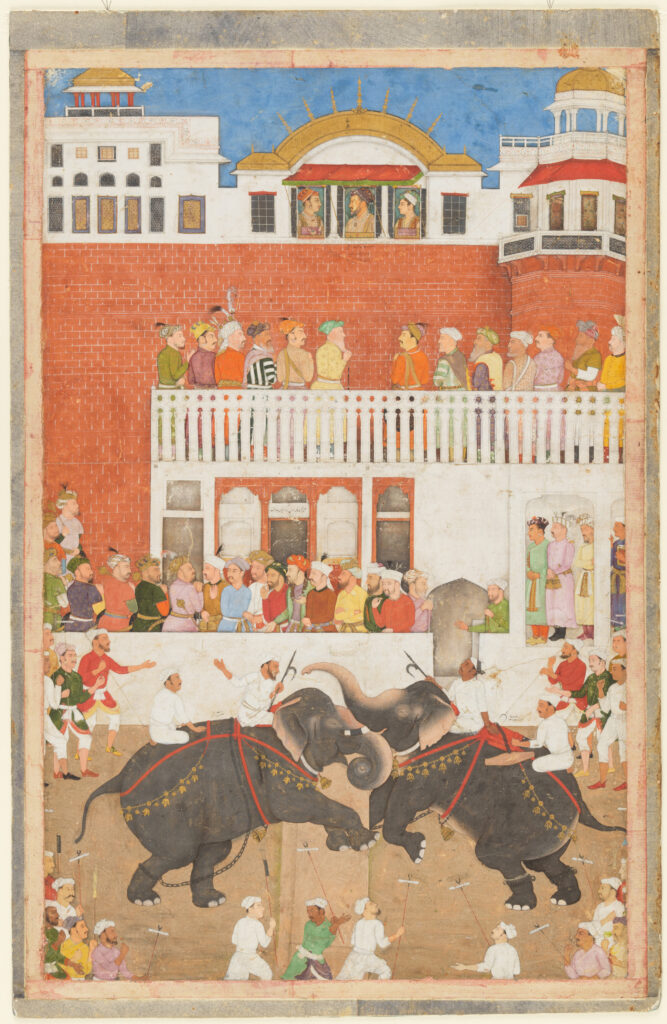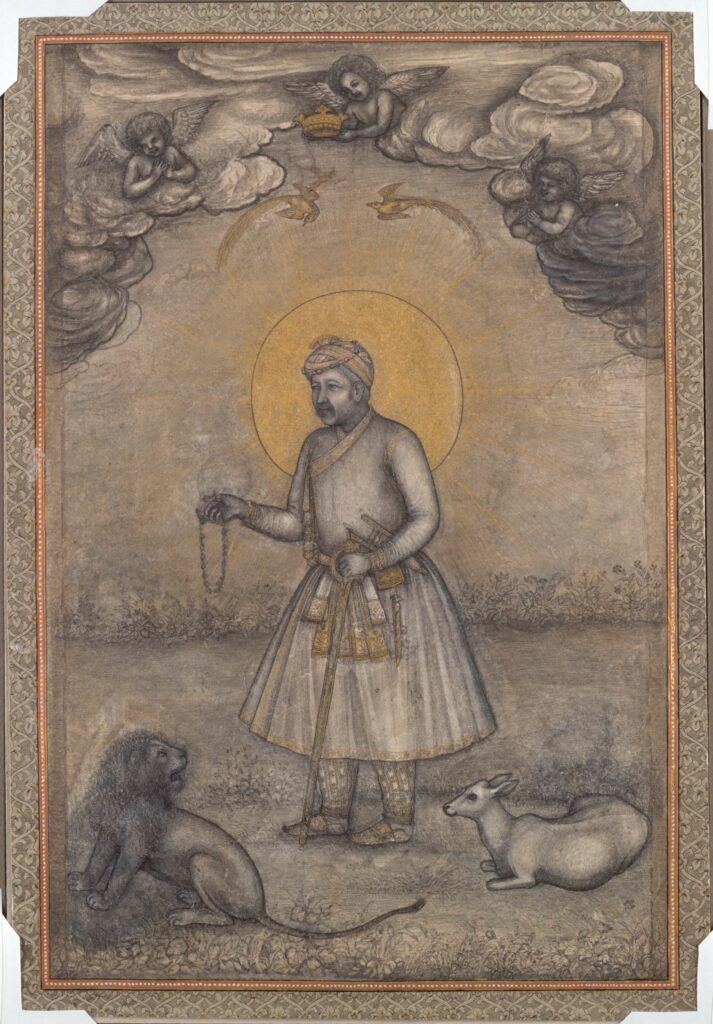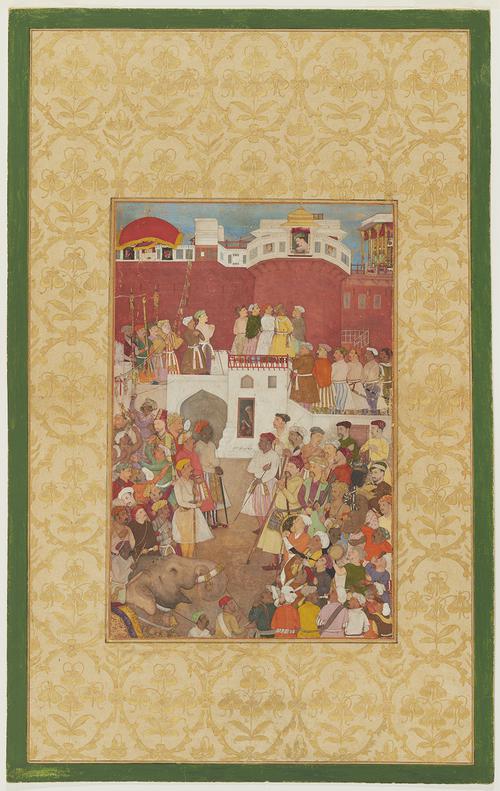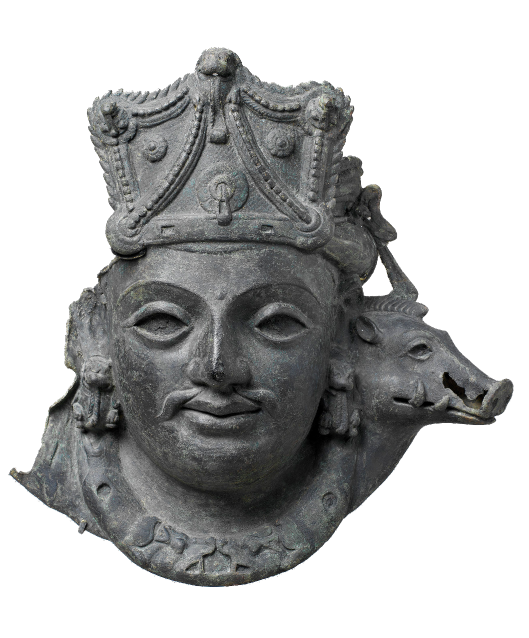PERSPECTIVES
Solar Symbolism in Mughal Art and Architecture
Every morning at the crack of dawn, the royal residence of the Mughal emperor was the site of an unusual spectacle. Expectant crowds gathered outside the fort walls before sunrise with their gaze set on the imperial east-facing balcony with a gilded sun-shaped roof. As the first rays of the sun appeared, the royal jharokha darshan unfolded. This formal, courtly practice saw the emperor offering a glimpse of himself (darshan) to his subjects by appearing at this highly ornate balcony (jharokha) built especially for this purpose.
Without saying a word, the Mughal emperor would not only announce his well-being to his empire but also establish his authority over his subjects through this expertly curated, solar-themed kingship practice. By closely associating his imperial identity with the sun, the jharokha darshan cemented his identity as the legitimate dynastic emperor. The ceremony, formalised and institutionalised as a daily practice by Akbar, and continued by his successors, Jahangir, and Shah Jahan, aimed to strengthen the legitimacy of Mughal rule in the subcontinent.

Arriving in India in the early sixteenth century, the Mughals found themselves in the position of having to firmly establish their authority in their new, fledgling kingdom. The daunting task meant ruling over the populace of “Hindustan,” a mosaic of religions, cultures, ethnicities, and differing loyalties. In addition to the traditional efforts at consolidating their rule, there was also the need to efficiently organise the administration of the new territory. This necessitated strengthening claims to imperial legitimacy and inspiring steadfast and single-point loyalty among its subjects to the emperor. One way to do so was to have the subjects believe that the Mughal king was “divinely appointed” to rule over them as the human embodiment of God’s light on earth.
This subsequently set the stage for developing a new imperial idiom where varied cultural influences from India, Central Asia, and Iran were brought together to build a kingship identity closely connected to the sun, a theme that existed in one form or the other in all these regions. Nevertheless, the traditions that stemmed from Indian antecedents became some of the most distinct examples of solar symbolism in Mughal courtly practices, such as the jharokha darshan. Actively attributing “sacredness” to the emperor, solar-themed ceremonies helped Mughal royalty consolidate power in a way that brute force, alone, could never have achieved.

Solar symbolism was especially prominent during Akbar’s long reign (r. 1556-1605), reflecting the need for the emperor’s identity to serve as a unifying factor in a rapidly expanding empire. Scholar Catherine B Asher points to three factors that shaped the solar iconography under the Mughals. One, the influence of the Chishti order of Sufi saints. Two, the discourse of eminent court scholars who delved into the work of the twelfth century Persian philosopher Shihab al-Din Yahya ibn Habash Suhrawardi on “Illuminationism,” an Islamic school of thought. Last, but not the least, the Mughals were also fascinated by the worship of solar deities by Hindus, Jains, and Zoroastrians.
Kingship practices around solar symbolism might have taken root under Akbar, but some of the most mature and striking visual examples emerged during the reign of his successors, Jahangir (r. 1605-1627) and Shah Jahan (r. 1628-1658). For instance, the portrait of Shah Jahan, painted soon after his succession, depicts the emperor standing atop a terrace with the luminous sun serving as the emperor’s “divine” halo. Similarly, a portrait of Akbar, commissioned by Shah Jahan, reveals a large, radiant sun doubling as the emperor’s halo, visually. Simurghs, mythological birds associated with the sun, are also depicted hovering over the scene. Such overt symbolism became an increasingly common feature of paintings by artists from the royal atelier, commissioned during the reigns of both Jahangir and Shah Jahan, and were often displayed in audience halls.

The jharokha darshan ceremony was the cornerstone of Mughal courtly rituals, embodying solar symbolism in both a metaphorical and literal sense. Popularised by Akbar, the ritual drew from older traditions and local practices native to north India, especially among Hindu kings. Fused with the devotional logic of darshan, an auspicious act of “seeing and being seen,” the ceremony allowed the sovereign to be imbued with the qualities of “sacredness,” akin to a deity on view in a temple. Conducted at dawn, from an east-facing, highly ornamented, and strikingly luminous balcony, the jharokha darshan kingship practice aligned time, direction, and architecture to the sun. It is worth noting that the Mughal adoption of this tradition did not amount to simple replication either. The ritual was reshaped from earlier formats to harmonise with the increasingly solar-themed idiom of Mughal sovereignty. This can be best understood from the architectural form of the jharokha itself.
By Shah Jahan’s reign, the jharokha’s very form, with its gilded semi-circular roof studded with seven finials, overtly resembled a radiant sun. Gilding the roof provided both symbolic and practical benefits. While gold in Islamic cosmology is a metal that is widely associated with the sun, its application on the roof would have made the structure appear to glow as sunlight reflected off it at sunrise, possibly creating an effect reminiscent of a halo. By Jahangir’s time, such golden roof structures — under which the emperor gave his subjects a glimpse of his royal person — was part of the established architectural template for palaces and forts. Paintings from this period also depict the “chain of justice” method, used by petitioners during the ceremony to capture the emperor’s attention, for seeking an on-the-spot hearing and ruling from the king. This practice meant that the emperor’s jharokha darshan was not merely ceremonial — it was also a governmental tool, designed to cement the king’s status as the ultimate arbitrator of justice in the kingdom. Each day, at dawn, the sacredness of the royal darshan met the pragmatic requirements of rulership.

Despite its advantages, jharokha darshan also had certain drawbacks. For instance, the emperor’s absence immediately signalled to the court that all was not right. When Shah Jahan fell severely ill in September 1657, preventing him from appearing for the ceremony, rumours of his imminent death spread throughout the realm. This was instrumental in triggering the succession war among his four sons, ultimately leading to Aurangzeb seizing power. This inherent risk was a key factor that led Aurangzeb to abolish the jharokha darshan in 1669. Aurangzeb would subsequently oversee the demise of solar symbolism traditions associated with Mughal kingship identity.
However, the legacy of the jharokha darshan ceremony endured. In 1911, when the British were facing growing resistance to their rule in India, King George V and Queen Mary, who had arrived for the Delhi Durbar of 1911, re-enacted a jharokha darshan from the Red Fort in Delhi for a vast crowd assembled below. However, this reenactment was a muted copy of the original Mughal ceremony, no longer connected to the sun in any manner. Although jharokha darshan both predated and outlasted the Mughal dynasty, there is no doubt that it acquired its distinct visual and architectural language under their rule.
Examples of solar symbolism also seeped into objects associated with the Mughal emperor’s authority, such as the imperial throne, flags, insignia and even coinage. Therefore, it can be argued that the Mughal empire openly adopted and adapted varied solar-themed cultural idioms, without restraint, to serve their imperial ambitions. By asserting the divine “right to rule,” Mughal emperors not only established their authority over a diverse populace, they also became the conduit through which power was vested in their ministers and members of the royal court to administer their vast kingdoms efficiently.
Robin Thomas is an architectural historian investigating invented traditions in imperial contexts using digital humanities methods. His ongoing PhD examines these traditions in British India, the Mughal Empire, and the Ottoman Empire.




